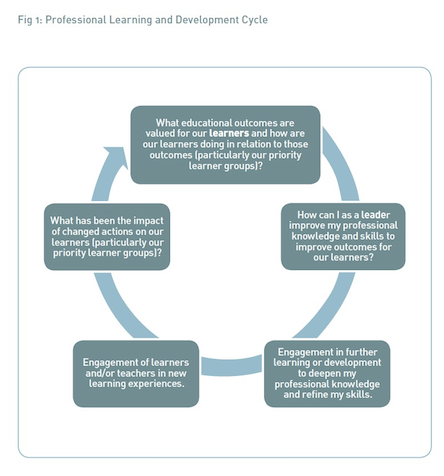Professional learning
Professional learning and development for principals provides benefits to principals, their schools and their boards.
A learning and development plan forms part of a principal’s performance agreement under s4.1.2(b) of the principals’ collective agreements.
Planning tips
There are common themes in the international professional development planning literature that provide useful tips for how to plan professional learning and development. These include:
Use evaluative techniques to establish baselines
Providing evidence gives a strong basis for why a particular set of learning activities will support the principal’s role as a school leader and manager, improve student outcomes, and progress the career of the principal. Evaluative techniques can include, but are not restricted to, such tools as:
- Self-evaluation or skills analysis techniques. For example, journaling, logs, blogs, personality and/or team psychometrics such as the NZCER teaching and school practices survey, or Tātaiako cultural competencies.
- Using evidential data to identify skill development needs. For example, school composition and performance statistics; area and/or regional demographics; 360 degree staff/student or stakeholder surveys; or cultural contextual information if it is available.
Link professional learning needs to the school strategic plan
Identify learning goals that are consistent with the board’s stated objectives for the development of the school and for agreed student achievement outcomes.
Link professional learning needs to student outcomes
Focus on learning that supports the ability of the principal to deliver the priorities the school has for student performance. In the New Zealand context this includes a particular focus on Māori learners, Pasifika learners, learners from low socio-economic backgrounds, and learners with special education needs.
Demonstrate relevance and the subsequent benefits
Show the broad based return on investment in the principal’s professional learning to students, staff, parents and the school community, and the individual principal.
Keep it simple, small and focused
Make the annual professional learning programme achievable in a single performance cycle, even though it may be contributing to a longer term vision for the school. It should not impose an unreasonable burden on the school or on the individual.
Learning and development cycle
The following model of the professional learning and development cycle depicts in broad terms the focus of professional learning.
The research evidence is clear that strong leadership is a critical factor in achieving good learning outcomes for students. Professional learning is an integral part of school leadership.

Fig 1 Professional Learning and Development Cycle – Adapted from Helen Timperley’s model of inquiry in BES: Teacher Learning and Professional Development
Professional conversations
Principals need to know what learning will strengthen their role as a school leader and enable them to meet the board’s strategic objectives and improve student outcomes in their school. At the same time, they will have personal career aspirations they may wish to pursue.
The Board of Trustees needs to be clear about the professional development they would like to see their principal undertake and know how this will benefit the school. They also need to think about how they are willing to support their principal’s personal career objectives, and have a clear view of the resources available or necessary to support the principal’s ongoing learning.
It is important that the principal and the board are clear about each other’s expectations of the learning to be undertaken, and the outcomes of that learning.
Part of the conversation should include a discussion on:
- Appropriate review periods during the year and the process for these: for example, you may be comfortable to review the PLD plan only if the principal wishes to discuss making adjustments to it. Or, you may prefer formal review points to assure yourselves that the plan remains on target and is appropriately resourced.
- Expectations for reporting progress and for evaluating the benefits of the principal’s professional learning at the end of the performance cycle. Keep in mind that the PLD plan for the principal is only one part of the overall performance management cycle so reporting should not be onerous.
Principals
You will be well positioned going into a formal conversation about your professional learning and development needs with your board, or their representative, if you can provide:
- A professional learning summary that provides information about the learning undertaken in the previous year and the benefits of that learning to yourself as a school leader, to the school and students, and to the broader school community – including hapū and iwi where applicable.
- A professional learning and development proposal for the coming year that includes learning goals, an outline of the learning opportunities you wish to take, and the support/resource requirements necessary to undertake them.
Boards
When discussing a professional learning and development proposal with your principal you may wish to explore:
- How the principal’s priorities for professional learning in the next performance period will:
- meet the relevant professional standards for principals
- contribute to the career progression of the principal in accordance with the career stages set out in the relevant Collective Agreement
- contribute to the achievement of the board’s stated strategic directions and goals
- meet the board’s stated student achievement goals, and improve equity for Māori learners, Pasifika learners, learners from low socio-economic backgrounds and learners with special education needs
- ensure the school is well led, well managed and well regarded by the school community – including hapū and iwi where applicable.
- How the principal’s learning goals for this period will contribute to their personal career development aspirations, and
- What resources are required and will be made available to enable the principal to undertake the agreed learning programme.
Related links
People and employment – Ministry of Education
Teaching, school and principal leadership practices survey – NZCER
Tātaiako: cultural competencies – Teaching Council
Tapasā: cultural competency framework – Teaching council
Updated November 2017
